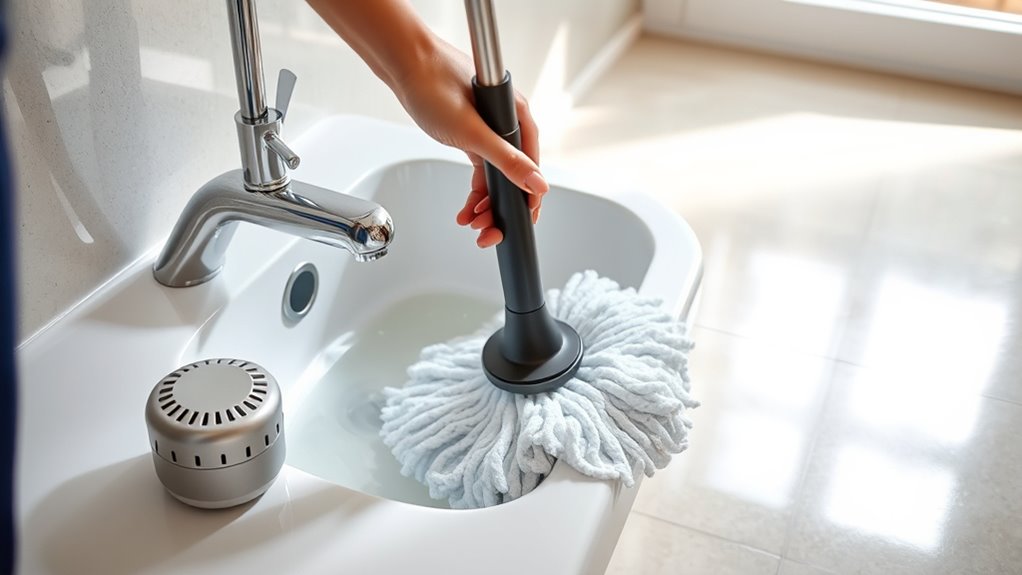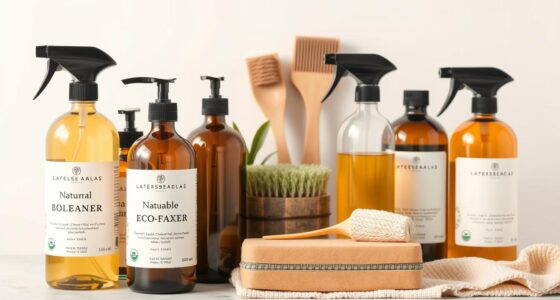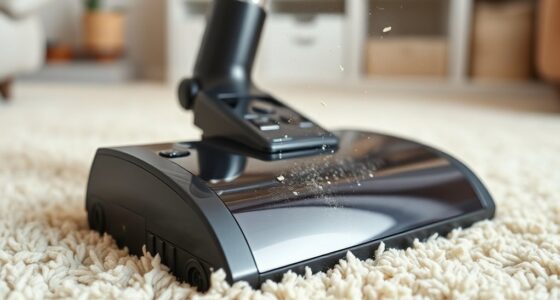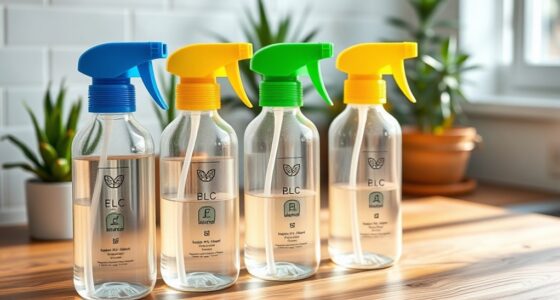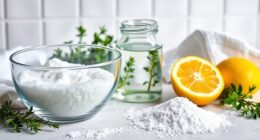To conserve water during mopping and scrubbing, use a bucket filled with just enough water and avoid leaving the tap running. Reuse cleaning water for multiple chores and opt for eco-friendly cleaning products that require less rinsing. Use microfiber cloths and mops to cut down on water needed for effective cleaning. Incorporate these easy habits and choose water-efficient tools—if you keep going, you’ll discover even more ways to save water effortlessly.
Key Takeaways
- Use a bucket with minimal water and avoid running taps continuously during cleaning.
- Reuse cleaning water for multiple chores to reduce overall water consumption.
- Opt for eco-friendly cleaning products that require less rinsing and produce minimal foam.
- Employ microfiber tools that trap dirt effectively, decreasing the need for excessive water.
- Schedule cleaning during off-peak times to lessen demand on local water resources.
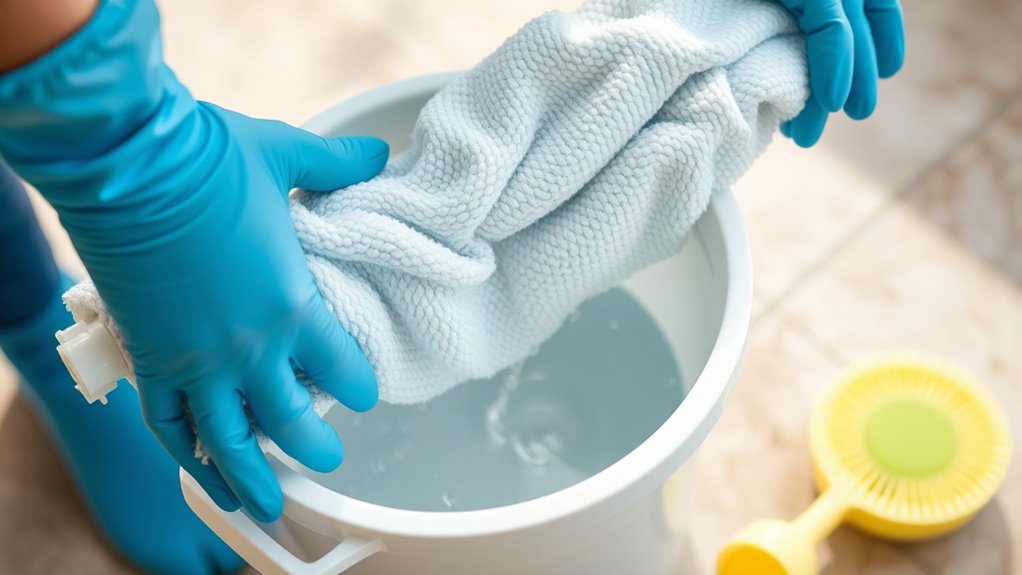
Have you ever wondered how your daily habits can make a difference in conserving water? When it comes to mopping and scrubbing, small adjustments can lead to big savings, especially if you focus on eco-friendly cleaning and water-saving techniques. Instead of letting the water run endlessly, you can adopt smarter methods that protect the environment and reduce your utility bills. For instance, using a bucket filled with just enough water for your cleaning tasks is one of the simplest yet most effective water-saving techniques. This way, you avoid wasting gallons by continuously running the tap. Whenever possible, opt for eco-friendly cleaning products that require less rinsing and are safer for the environment. These products often produce less foam and residue, which means you can use less water overall.
Using a bucket with just enough water and eco-friendly products helps save water and protect the environment.
Another effective water-saving technique involves damp mopping instead of soaking the floor or surface. When you use a mop, wring it out thoroughly to minimize excess water that could drip off or splash unnecessarily. This not only conserves water but also ensures that your cleaning is more efficient, as a well-wrung mop picks up dirt better without needing excessive amounts of water. For scrubbing, consider pre-treating stubborn stains with eco-friendly solutions that loosen grime without requiring you to use too much water during the scrubbing process. This approach reduces the need for multiple rinses, saving water in the long run.
Using water-efficient tools such as microfiber cloths and mops can significantly cut water use, as these materials trap dirt and dust better than traditional options, so you don’t need to rinse as often or use large amounts of water. Additionally, reusing cleaning water for multiple tasks can cut down on waste—simply save the water in a basin and use it for other cleaning chores around your home. This practice maximizes the use of every drop and minimizes unnecessary water consumption.
Lastly, consider timing your cleaning routines during cooler parts of the day or when water demand is lower in your community. While this might not seem directly related to water conservation, it helps reduce strain on local water supplies and encourages a more mindful approach to resource use. By integrating eco-friendly cleaning practices and water-saving techniques into your mopping and scrubbing routines, you contribute to a more sustainable environment. These small adjustments are easy to implement and can make a lasting impact, proving that your daily habits really can help conserve water and protect the planet.
Frequently Asked Questions
Can Using Eco-Friendly Cleaning Products Reduce Water Waste?
Yes, using eco-friendly cleaning products can reduce water waste. These products often contain eco-friendly ingredients that require less rinsing, saving water during cleaning. Plus, their biodegradable packaging encourages sustainable disposal, reducing environmental impact. When you choose eco-friendly options, you’re not only protecting water resources but also supporting a healthier planet. So, switching to these products helps conserve water while making your cleaning routine more environmentally responsible.
Is It Better to Mop With a Bucket or a Spray Method?
Using a mop bucket is generally better for water conservation because it allows you to reuse the water multiple times, reducing waste. However, if you’re in a hurry or want to use less water overall, spray mopping is a quick, efficient alternative. It uses less water per cleaning session and minimizes waste. So, choose a mop bucket for thorough cleaning or spray mopping for quick, eco-friendly touch-ups.
How Often Should I Change the Water During Mopping?
You should change the water frequently during mopping to maintain water hygiene and guarantee effective cleaning. Typically, replace the water when it becomes visibly dirty or after every room or area, especially if you’re cleaning a large space or high-traffic areas. Regularly changing water helps prevent spreading germs and dirt, making your cleaning more efficient and hygienic. Adjust the frequency based on your cleaning needs and the level of dirt.
Do Different Floor Types Require Different Water Conservation Methods?
Think of your floors as delicate tapestries needing tailored care. Different floor materials demand unique cleaning techniques to conserve water effectively. For instance, hardwoods prefer minimal water, while tile can handle more. By adjusting your methods—using damp mops instead of soaking—you respect each surface’s needs. This approach not only preserves your floors but also helps you save water, turning cleaning into a mindful act of preservation and respect for your home’s unique character.
Can Reusing Rinse Water for Mopping Save Water?
Reusing rinse water for mopping can definitely save water. By practicing rinse water reuse, you reduce waste and promote water recycling, which conserves valuable resources. When you collect and reuse rinse water for subsequent mopping, you cut down on the amount of fresh water needed. This simple step makes a big difference in water conservation efforts and helps you maintain a more sustainable cleaning routine.
Conclusion
By following these simple water-conservation tips during mopping and scrubbing, you’re not just saving water—you’re helping to nurture our planet. Every drop you save is like a tiny seed of hope, blossoming into a cleaner, greener future. Remember, small actions ripple outward, making a big difference. So, next time you clean, think of yourself as a water hero, protecting our precious resources for generations to come.
